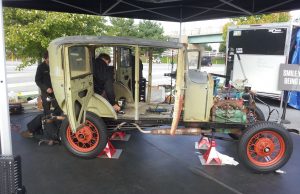
Hagerty’s Hershey Swap to Street Challenge Holds Court
Since 1955, the Antique Automobile Club of America’s Hershey Region has been host to the AACA’s Eastern Division Fall Meet, which grew rapidly and organically into the world’s largest automotive swap meet. Your correspondent first attended in 1970 (yes, I am the oldest member of the CarShowSafari team) and has made it a regular October appointment ever since.
 How big is it? Well, the swap meet is only a portion of the activities in and around the event, and the swap meet consists of more than 9,000 flea market spaces!
How big is it? Well, the swap meet is only a portion of the activities in and around the event, and the swap meet consists of more than 9,000 flea market spaces!
In recent years there have been concerns that the internet might be killing off automotive swap meets, and there has been a parallel concern that, as car collectors and restorers age out of the hobby, fewer younger people are taking their place. At Hershey this year, we saw evidence to both bolster and contradict those concerns.
This year, there was a noticeable number of vacancies in the flea market, vendor spaces that remained unoccupied. True, these were a tiny percentage of the 9,000+ swap meet spaces, but the vacancies were visible. Is this evidence of the effect of the internet, or of old persons not being supplanted by younger ones?
Two vendors with whom we are acquainted, both of whom were not there this year, each missed the event due to last-minute conflicts. Two vendors is hardly an adequate sample, but it was neither the internet nor age that kept them away.
Sales, many vendors reported, were soft. Is this softening the result of internet sales and/or a dying-off of old car collectors?
At the same time, we saw a remarkable number of younger hobbyists carrying new-found vintage treasures home. Where recently it would be only an old geezer toting a vintage radiator shell away from the flea market, this year we were struck by the number of 80- and 90-year-old car parts being purchased by 30-something enthusiasts. And where previously only senior citizens would be trading pre-war parts, this year we saw much younger persons selling and buying Depression-era pieces.
Further illustrating this was Hagerty Group’s Swap to Street Challenge, in which for the second year in a row a team from the insurance company attempted to assemble a running-and-driving vintage car at the flea market, using parts and pieces found at the flea market. The Hagerty display was a beehive of activity – and it was a beehive populated with people skewing much younger than the popular notion of old-car enthusiasts.
Last year, the team was successful in assembling a 1946 Ford pickup, having started with little more than a chassis and a cab. This year they started with a 1930 Ford Model A chassis which, while it had brakes, a transmission and an engine of unknown condition, was otherwise a blank canvas. Everything else had to be sourced from the Hershey swap meet – no eBay, no Craigslist, just old-fashioned flea market hunting and face-to-face transactions.
In fairness, the high visibility of the Hagerty project did help, as vendors and individuals stopped by the assembly area to offer needed items. But the Swap to Street Challenge was nonetheless a challenge, and as we write we do not know whether the Hagerty crew achieved their goal of driving the car back to their Michigan home base. When we last visited their display on Friday morning at Hershey, a sedan body was on the car, the car had wheels and tires, and the engine was running.
While visiting the Hagerty display at one point we chatted at length with a Hagerty staffer who spoke enthusiastically of his own 1960s collector car – a car that was already eligible for vintage registration and insurance by the time its owner was born. This, we think, and a 1930 Ford Model A assembled from swap meet parts by younger enthusiasts bodes well for the future of the hobby. ![]()
Photo by Bob Marlow for CarShowSafari

